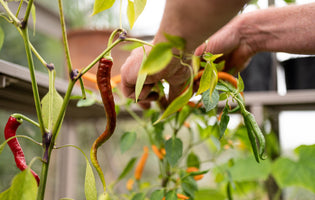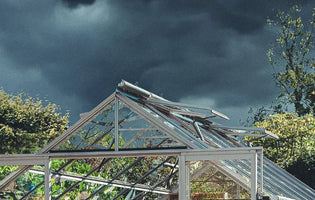Whether in the house or outside the home, everyone feels the effects of rising costs. At Rhino Greenhouses Direct, we’re all for exploring savvy water-saving tips which not only benefit your pocket but the planet too.

Why it’s important to waste as little water as possible
Experts worldwide agree that water is fast becoming one of the planet’s most precious and dwindling natural commodities. Water is a vital resource that all life on earth requires to live and survive. However, fresh, clean water is becoming a much more limited resource, especially as severe droughts occur more frequently across the globe.
“At Rhino Greenhouse Direct, we recognize the crucial role we can all play in protecting our valuable natural assets. Saving water in the garden has become a vital component of responsible gardening. As a nation of avid gardeners, we need to find innovative, effective ways to save water and protect the environment,” says Andrew White from Rhino Greenhouses Direct.
“We all need to start cutting down and conserving our water usage as much as possible. This means we need to start using our water more wisely and creating far less water waste,” Andrew White adds.
When is the best time to water your crops and garden?
Questions surrounding watering plants and picking the most optimal time to water are often on gardeners’ minds. If the past summer’s record-breaking high temperatures and lack of rainwater are anything to go by, we need to heed the climatic writing on the wall. At Rhino Greenhouses Direct, we offer valuable advice for gardeners on topics such as waste water, conserving rainwater, effectively conserving fresh water, using water butts, and limiting the amount of water used during dry weather spells.
Generally speaking, it’s advisable to water your garden in the early morning or later in the evening. When you water in the morning, the sun is scarcely up, and temperatures remain cool. The water has time to penetrate the soil and make its way down into the root systems of the plants without too much being lost to evaporation. If you choose to water in the evening, try not to cover your plants’ leaves. Damp leaves cause diseases such as powdery mildew.
“In a greenhouse, the watering frequency and techniques will depend on the type of plant you are growing, combined with the outdoor conditions. Similar to conventional outdoor gardening, the best time to water a greenhouse is first thing in the morning. This gives the plants adequate time to dry out, helping avoid fungal problems and pests such as slugs causing damage. Watering plants late in the evening reduces evaporation. But bear in mind your plants may not be totally dry before it gets dark,” explains Andrew White from Rhino Greenhouses Direct.
How to save water in your garden by planting low water/plants that need little water
Finding clever ways of saving water in the garden has a lot to do with making informed choices on which plants need less water to thrive. There are so many amazing water-wise plants to choose from. Whether it’s color, texture, or variety you’re after, or mouth-watering fruit and veggies – you’ll find plants that aren’t overly thirsty to help with saving water in the garden.
Decorative plants
- Rock roses
These vibrant, pretty flowering plants are popular for their ability to display fresh new flowers daily throughout summer. The Cistus x pulverulentus 'Sunset' is a bright pink-hued rock rose high on the list of drought-tolerant evergreens. It’s also readily available at nurseries and garden centers.
- Tree Lupin
The tree lupin looks fabulous against a south-facing wall. Lupinus arboreus can cope well with dry soil conditions because it originally hails from the Californian sand dunes – so it can certainly cope with dry soil. With its pretty two-tone yellow flowers, this fragrant plant makes a lovely backdrop.
- 'Limelight’ for fresh-looking foliage
Helichrysum petiolare, or ‘Limelight’, is a brilliant drought-tolerant addition if you want to know how to save water while gardening. Much admired for its soft yellow-green foliage, it’s often used in containers or raised beds like our Rhino raised beds.
- Blue Spire
Persia or ‘Blue Spire’ is a popular choice. It does well in a range of dry soils and has pretty plumes of violet-blue flowers and attractive silvery foliage.
Fruit/vegetable plants
If you’re after nutritious and delicious options on how to save water in your vegetable garden, consider adding the following fruit and vegetables to your list of water-saving tips and tricks:
- Swiss chard
- ‘Black Aztec’ corn
- Asparagus (once established)
- Sweet potato
- Rhubarb (once mature)
- Sugar Baby watermelon
- ‘Hopi Pink’ corn
- Jerusalem artichoke
- Green-striped cushaw squash
- ‘Iroquois’ cantaloupe
- Eggplant
- Mustard greens
- Okra
- Globe artichoke
- Peppers
- Armenian cucumber
What to do if your current greenhouse doesn’t support water collection. How to use water butts for saving water in the garden.
If your current greenhouse doesn’t have gutters, it is relatively simple to add them to your greenhouse. Most hardware stores will sell gutter parts, simply measure your greenhouse, buy the right parts and fix these to your greenhouse to create your DIY gutters.
At Rhino, we like to solve these problems for our customers which is why all of our greenhouses come with large integral gutters and downpipes as standard to help rainwater feed into water butts.
Water butts are a popular, inexpensive method of rainwater harvesting where rain from the rooftop is redirected through downpipes and collected in a storage container. Should you wish, the downpipes on a Rhino greenhouse can be connected via rainwater collection kits, allowing both downpipes to feed a single water butt, harnessing nutrient-packed rainwater for you to use at a later date - your vegetable garden will love you for it.
Why not check out Rhino Greenhouses Direct for our range of innovative rainwater collection solutions?







